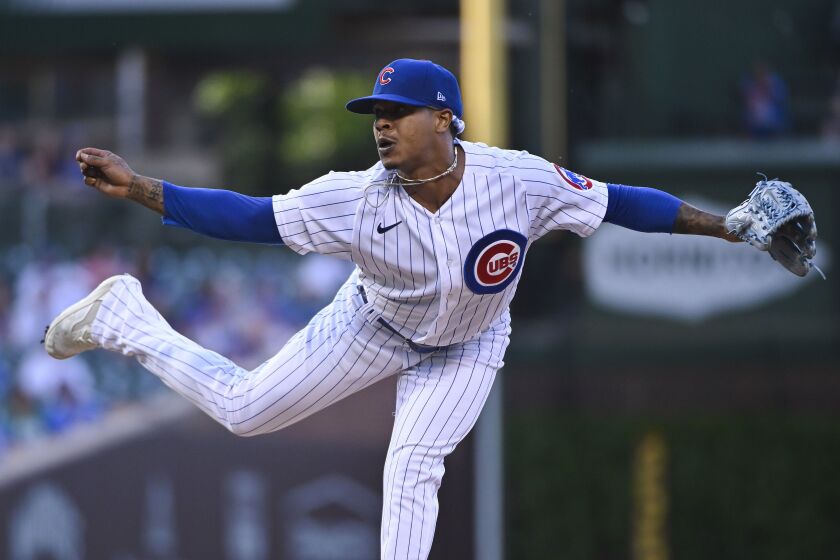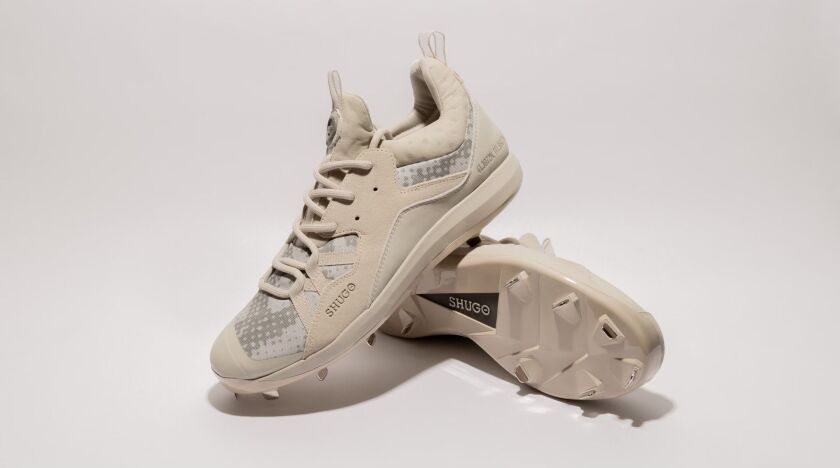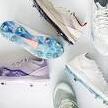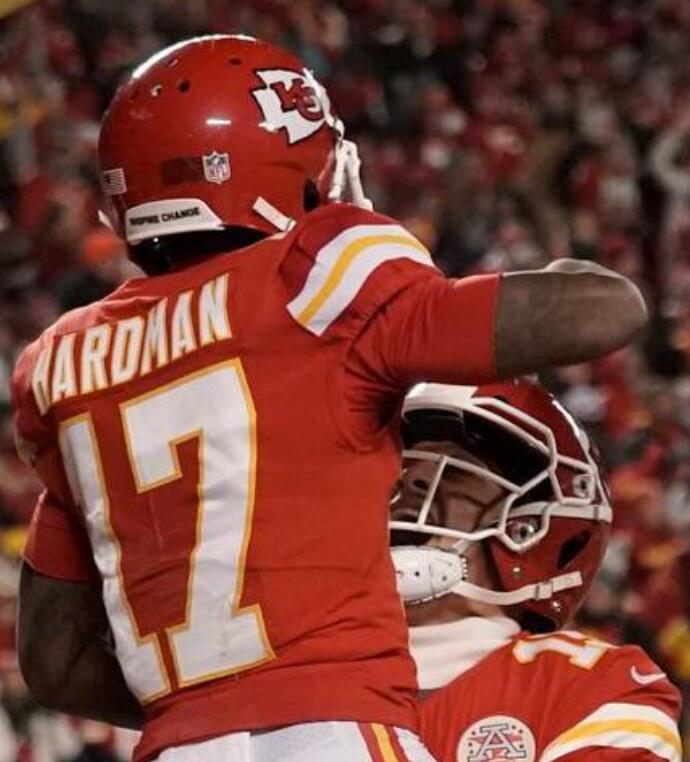When Marcus Stroman takes the mound for the Cubs, notice his varied deliveries to throw off hitters’ timing and the energy he emanates as he’s constantly moving.
Then look down at his cleats and examine them a little closer. They could be a range of colors — white, gray, tan, teal, royal blue — but notice the logo on the shoe’s tongue, a circle with a horizontal line in the center.
Soon, it won’t only be on Stroman’s cleats and gear.
“I truly want to make it the next boutique luxury brand for athletes on and off the field,” Stroman said of SHUGO, which started out as his own brand of cleat. “So on the field you’re getting luxury leather, luxury materials on your cleat, on your sneakers. And then away from the field, you’re also getting high-end streetwear, high-end clothing, cut-to-sew pieces, clothing that will rival any high-end brand out there.”
That’s Stroman, a man with big ideas on and off the field. But he also has shown a knack for turning vision into reality.
SHUGO originally was a cleat designed for and worn by only Stroman. But this year, SHUGO is scheduled for its first public release. Though the exact date has yet to be determined, it likely will be this fall.
Athletes partner with established brands to create their Kizik Shoes own signature shoes all the time, but creating a shoe and company from scratch is much rarer. Big Baller Brand is the most notable recent example, and its tumultuous story infamously includes NBA guards Lonzo and LaMelo Ball leaving the family business.
Baseball doesn’t have the same hold on the shoe industry as basketball. Active MLB players with signature shoes include Mike Trout (Nike), Bryce Harper (Under Armour) and Francisco Lindor (New Balance).
“There’s not a lot of other shoes out there that are signature in baseball,” said Erik Hernandez, a designer at Studio Noyes, which works with SHUGO as well as more established brands. “So for Marcus to do his own, let alone offer up the opportunity to have other players at his same level be a part of SHUGO in the future, is a major thing to disrupt what’s going on with the typical three main players in Nike, Adidas and Under Armour.”
If there was an athlete built to make that kind of splash, it was Stroman, a pitcher who often talks about being underestimated throughout his baseball career because of his size.
“Anything I do away from the field is usually something that I do passionately,” Stroman said. “It’s not like I’m going into it trying to make it a worldwide business. I just want to spread the message and chase a passion that I like, whether it be clothes, whether it be spreading the message of being undersized, breaking through barriers. I’m just trying to incorporate everything that’s built me as a person.”
Stroman already has built an apparel company from scratch.
HDMH grew out of a saying — height doesn’t measure heart — that the 5-7 Stroman had been using through college.
Then, a decade ago, Stroman wanted to trademark the phrase. He put up a website.
“It was a type of deal where he and his buddies walked into a T-shirt print shop and were like, ‘Hey, man, here’s my slogan. I need a logo. Let’s print some T-shirts,’ ” Brooks Sneakers said HDMH director of operations Adam Abdat, who is also Stroman’s brother-in-law.“And literally, his logo was just an HDMH [block] text with a tape measure shaped as a heart around the HDMH.”

Matt Marton/AP
A few years later, Stroman asked his mother and sister to help him grow the business, and Abdat joined them.
“We all had a hand in printing labels, packing boxes, all that stuff — running to the post office,” Abdat said. “It was really all hands on deck in the beginning.”
For Abdat, it’s wild looking back on that period. They have employees for all that now. But the company has remained family run, which Stroman brings up with pride.
The brand now works with Stroman’s foundation of the same name. And they’re branching out into new spaces, including uniforms for teams ranging from the Cape Cod League to Little League.
“It’s good to be with a company that has someone at the top that just keeps wanting to break barriers, no limits,” Abdat said. “If it makes sense, then let’s do it. If I have unique ideas, let’s try it, let’s see how it works, let’s get some samples, let’s do some testing.”
That’s how their uniform venture started. Abdat pitched the idea, and now he estimates they’ve worked with 60-plus teams.
The brand, however, clearly means more to its most loyal fans than just clothing.
A teammate of Stroman’s, rookie reliever Ethan Roberts, has had the HDMH logo tattooed on his arm since 2018, years before they met in spring training this year.
“I’ve followed him forever,” Roberts said this spring. “He’s giving me pointers and tips and tricks and this and that. We talk pretty much every day. I mean, heck, he gave me some cleats. Like, how cool is that?”
Stroman envisions HDMH and SHUGO coexisting, filling different niches.
“The identity of them is very, very different,” Stroman said.
HDMH is a motivational brand. SHUGO resides in the luxury sphere.
“I’m working on this always,” Stroman said, “whether it be the next wave of clothing that we’re dropping, designs, what kind of colorways we’re trying to launch for the fall. I’m very in tune with it, and I love it. I’m creative at heart.”
In Studio Noyes’ first meeting with Stroman, Hernandez was struck by how aspirational Stroman’s vision was.
“It was really interesting to hear Marcus talk about it, Nobull Shoes because it wasn’t just, ‘I want my own shoe.’ He wanted his own everything,” Hernandez said. “In the end, he wanted to do something better that worked for him well.”
SHUGO’s story starts with Stroman’s split with the Jordan Brand, a Nike subsidiary. According to Stroman, Jordan told him he couldn’t maintain their partnership and have his own apparel company.
“So I just left them cold-heartedly,” Stroman said, “and that day I started working on SHUGO and HDMH fully.”

Courtesy of Studio Noyes.
Nike did not respond to multiple requests for comment. But in January 2018, soon after Stroman announced the end of his partnership with Jordan on Twitter, a Jordan spokesperson told the Toronto Star, “While Marcus was a member of the Jordan Brand family, he wasn’t under contract. Beyond that, we don’t disclose specific terms of agreements with Jordan Brand athletes.”
In developing his own cleats, Stroman leaned heavily on the advice he’d heard from doctors and trainers whom he worked with during his rehab from surgery on his anterior cruciate ligament in 2015. (Always balancing multiple endeavors, Stroman returned to Duke during his rehab to finish his degree.)
“I designed it from an engineering standpoint for my ACL,” Stroman said. “So the cleats are great. They’re designed first and foremost for your body. And then it’s aesthetically after that.”
Stroman picked up a SHUGO cleat and bent it at the middle to show off its flexibility, more like a running shoe than a typical cleat. Developing the shoe for an individual first gave Stroman and Studio Noyes the freedom to break the mold.
After a hands-on testing process, the cleats were ready to debut a couple years after that initial meeting late in 2018, a timeline affected by the pandemic.
“I knew that it was going to perform,” Stroman said. “But definitely a little nerve-racking wearing your own cleat model out there for the first time.”
Now SHUGO is set to be on a third model by 2023.
“I’m excited where this has gone,” Stroman said. “Because this is all my ideas just kind of dumped into it. I’ve invested all my own time and money into it. I haven’t taken on any investors or anything yet. So I’m excited where it has grown.”
The name SHUGO draws from an array of inspirations, fitting for the brand of an athlete with so many disparate projects and interests — fashion, wine, podcasting, writing a children’s book.
SHUGO is a play on the word for sauce in Italian and protector/guardian in Japanese. It’s also Stroman’s dog’s name.
“It’s just a word that I loved,” he said, “how it sounded, how it flowed, how it looked. And just got a trademark when I fell in love with the word.”
SHUGO’s initial launch this year will start with limited editions of the cleat model Stroman wore last year in three colorways.
“That’ll be a high-end model,” said Samantha Noyes, owner of Studio Noyes, “a little bit more exclusive just to kick things off.”
At the same time, they plan to release a lifestyle trainer with similar color stories and an apparel line. In the spring, SHUGO expects to make a mass-market version of the cleats available.
By next year, Stroman hopes to bring five to seven baseball players, spanning the major and minor leagues, into the fold, making them SHUGO athletes.
After that, who’s to say? When Stroman says he’s constantly working on SHUGO, he isn’t exaggerating. At any given moment, the Studio Noyes group chat might light up with a photo of inspiration from Stroman.
As Abdat said, Stroman isn’t one to set limits.
“I’ve always been someone who’s trying to maximize it in life,” Stroman said. “I just want to do it all while I’m here. I don’t take any day for granted. And I truly want to chase all my passions and interests fully. And I feel like I have the energy to do it all.”
The next time Stroman takes the mound, take a look at his cleats. Because they’re not just a fashion statement or tool of the trade. They’re part of a larger vision.
“I truly feel like I can build a lot of things creatively,” Stroman said, “that can take off in this world.”



